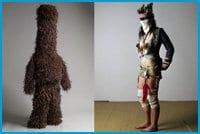I’m not entirely sure what Museum Of Contemporary Canadian Art (MOCCA) curator David Liss means when he calls the meeting of art and fashion an “unholy alliance,” the title of the gallery’s current group show. The phrase suggests a dark and dangerous cabal set to wreak satanic havoc on an unsuspecting world. If anything, MOCCA’s latest exhibit, showcasing art and fashion’s mutual pillaging for inspiration, demonstrates that the two fit quite nicely together, wreaking nothing so much as an abundance of prettiness and an ironic sense of humour. I’m more inclined to think the title was chosen to provide Liss with another excuse to use one more gothic, death-metal typeface for the gallery signage.
The roster of assembled artists declares the show’s preferences, leaning heavily toward the art side of things. Liss amasses work by Kent Monkman, Lydia K, Nick Cave (not that Nick Cave; this Nick Cave is a queer black artist from Chicago), Clemencia Labin, Mathew Vescovo, and, for the sake of balance, über-fashionistas Viktor And Rolf.
Toronto-based Kent Monkman is the star of the show, if only in terms of the sheer amount of work. Monkman’s contributions — a video, two paintings, a series of photographs and a plethora of costumes — could easily fill their own show. He continues his Canadiana-subverting project, further deepening the mythos of his beloved frontiersman-deflowering alter-ego Miss Chief Share Eagle Testickle. With its clear, thematically unified focus, painstaking execution and use of prodding humour to deliver a powerful statement on the constructions of national mythologies, his work fares the best in the crowd.
Clemencia Labin’s contributions are a bit baffling. Her most visible work consists of wrapping MOCCA’s structural columns in great pillows of brightly coloured fabric. This is purely frivolous decoration, and the accumulated effect of these constructions is a kind of irritating zaniness. Far from seeming spontaneous and joyful, their matchy-matchy designer colours seem contrived, studied and mannered; it all ends up looking like a bad Todd Oldham rip-off.
Nick Cave’s Soundsuits are gorgeous constructions. There are three of them at MOCCA, flawless full-body cat-suits, each the result not only of hours upon hours of work, but also of material research. In addition to using traditional embroidery and embellishments, Cave trawls flea markets and antique shops for inspiration. Two of his suits — intricately beaded, sequined, fussed-over — are clearly wearable, and the third is composed entirely of wooden sticks. All of his suits are designed for performance, which is the one small disappointment. Even when presented on stiff mannequins, they are a visual knock-out so I can only imagine what they look like in motion.
Fans of Lydia K (I include myself in this category) will be let down by her work at MOCCA, especially considering the unqualified excellence of her showing at Katharine Mulherin Art Projects last month. Here she shows more traditional garment pieces, on mannequins and in photographs. The photographs of the clothes fare better than the things themselves, largely because they are animated by a human figure who meets our gaze. Hovering on mannequins on the gallery floor, the clothes seem hollow, robbed of any context. A saving grace is a textile sculpture of what looks to be sequined internal organs hanging from the ceiling, delicately encased by a white hoop skirt. Its marriage of abject biological gore, saturated colour and meticulous craftsmanship fits the tone of the show far better than her clothes, and showcases the skill and intelligence that was on display at Katharine Mulherin.
Rounding out the show is Matthew Vescovo and Viktor And Rolf. The latter are represented by footage of their runway shows, which, quite frankly, seems like space-filler; this is nothing you can’t see on a Fashion File rerun. Vescovo has done a children’s book history of the word “Bling,” its rise to prominence and ultimate demise at the hands of trend-obsessed honkies. It’s cute and worth a chuckle or two but ultimately amounts to not much more than an expensively-made one-note gag.
As a whole, the show is certainly worth a gander. There’s enough to dazzle the eye and please the senses to make up for the pap. Still, given Liss’s hyper-engorged rock-star curatorial aesthetic, I expected more. I wanted to see that “unholy alliance,” those avenging angels of fashion and art. What the show amounts to, however, is something more like a couple of runway queens out for brunch and some window-shopping.

 Why you can trust Xtra
Why you can trust Xtra


